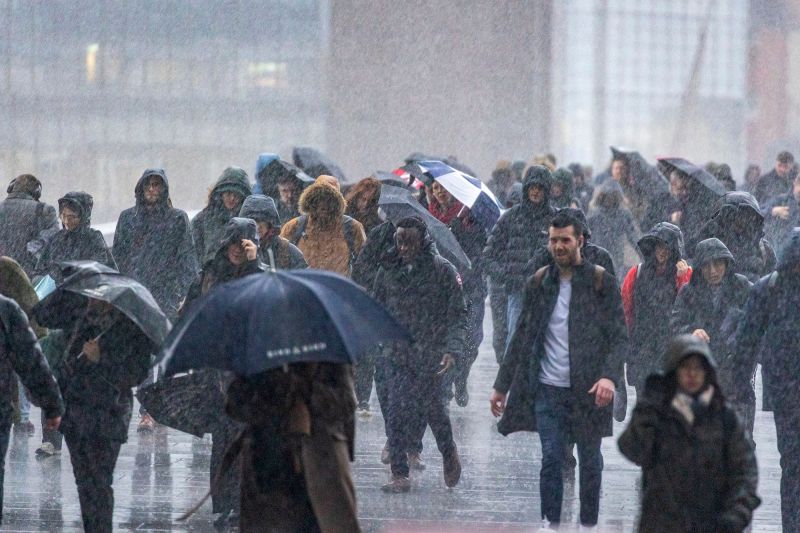A rare “stay at home” warning has been issued for parts of the United Kingdom and Ireland as a severe storm lashes the region, bringing dangerous 100mph (160 kmh) winds and unleashing travel chaos.
Storm Éowyn, an extratropical “bomb” cyclone that has formed in the North Atlantic and intensified rapidly, has hit rail services, delayed flights and forced road closures.
The strongest winds and most significant impacts are expected in Northern Ireland and central and southwestern parts of Scotland, according to the UK’s Met Office. A red weather warning was established Friday morning local time in Northern Ireland and parts of Scotland.
A yellow warning for snow is also in force through Friday for northern and central areas of Scotland. While accumulations are possible over high ground, it’s likely to shift to sleet and rain at lower levels through the day, the Met Office said.
Currently more than 93,000 homes and businesses in Northern Ireland are without power, according to the Northern Ireland Electricity (NIE) Networks. “Restoration efforts will take significant time as crews cannot begin to work until it is safe to do so,” the supplier said.
Northern Ireland’s First Minister Michelle O’Neill has given a “stay at home” warning to residents, telling BBC Radio Ulster that they are now “in the eye of the storm.”
According to Met Éireann, Ireland’s Meteorological Service, a gust of 113 mph was recorded at Mace Head Co. Galway at 5 a.m. local time — provisionally the strongest gust speed ever recorded in the country.
All schools in Ireland and Northern Ireland were closed on Friday, while hundreds were also shuttered across Scotland, with Scotland’s First Minister John Swinney also warning against travel.
Public transport has been severely disrupted by the storm. Train operator ScotRail has suspended all services across Scotland on Friday, saying it “would not be safe to operate passenger services.”
Other rail services affected by the storm include Avanti West Coast, LNER, West Midlands Railway, Lumo, Transport for Wales and South Western Railway.
Many flights have been canceled in the region. More than 1,070 flights scheduled to operate from the UK and Ireland were called off on Friday, the UK’s PA Media reported.
Dublin Airport announced later Friday that flights had recommenced from its runways after winds had “eased somewhat,” however it could not rule out further cancellations throughout the day.
Meanwhile motorists in areas where red and amber weather warnings are in place have been advised against non-essential travel.
Social media platforms were awash with images of the damage caused by Storm Éowyn. Dublin Fire Brigade posted a photo of collapsed scaffolding in an inner city Dublin suburb, saying that the road is “completely blocked.”
Another image shared by the fire brigade showed supermarket shelves almost completely emptied of bread.
A photo taken in Durham county, in England’s north east, shows an overturned lorry after it ran into trouble in high winds on a major road.
In Ireland’s Galway harbour city, trees that had stood for over 60 years were uprooted by the storm, locals said.
“(I) got woken up before the red alert even started, the winds were crazy,” sports scientist Cathriona Heffernan, 25, from Galway, said.
“Those trees have been there 60 years and outdate the houses even. It’s sad seeing them down all the same but just glad no damage was caused by them.”
Éowyn is expected to move away from the UK on Saturday, although yellow wind warnings are in place in Scotland and Northern Ireland for Saturday morning and early afternoon.
Ambrogio Volonté, a senior research fellow at the University of Reading’s Department of Meteorology, warned Storm Éowyn could “rival the ferocity” of Storm Eunice in 2022 and Storm Ciarán in 2023, “both of which sadly claimed lives and left behind severe damage.”
Leach said Éowyn is an extratropical bomb cyclone that has formed in the North Atlantic and “intensified extremely rapidly.”
He said bomb cyclones are typically the most impactful winter storms in Northern Europe.
While Leach said the impacts of the climate crisis on extratropical cyclones remain uncertain, some studies suggest the most severe storms may be getting stronger with climate change.

























